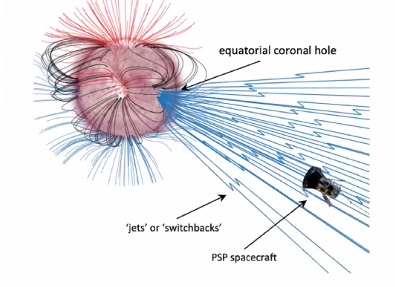
Bale, S. D., S. T. Badman, J. W. Bonnell, T. A. Bowen, D. Burgess, A. W. Case, C. A. Cattell, B. D. G. Chandran, C. C. Chaston, C. H. K. Chen, J. F. Drake, T. Dudok de Wit, J. P. Eastwood, R. E. Ergun, W. M. Farrell, C. Fong, K. Goetz, M. Goldstein, K. A. Goodrich, P. R. Harvey, T. S. Horbury, G. G. Howes, J. C. Kasper, P. J. Kellogg, J. A. Klimchuk, K. E. Korreck, V. V. Krasnoselskikh, S. Krucker, R. Laker, D. E. Larson, R. J. MacDowall, M. Maksimovic, D. M. Malaspina, J. Martinez-Oliveros, D. J. McComas, N. Meyer-Vernet, M. Moncuquet, F. S. Mozer, T. D. Phan, M. Pulupa, N. E. Raouafi, C. Salem, D. Stansby, M. Stevens, A. Szabo, M. Velli, T. Woolley, and J. R. Wygant, Highly structured slow solar wind emerging from an equatorial coronal hole, Nature, 576, 237-242 (2019) (ADS)

(click on the image for a larger version)
Date: 2020 March 21
Here we see the Parker Solar Probe's celebrated "switchbacks", actual kinks in the heliospheric. These can actually reverse the Parker spiral locally, and at the time of writing this note, controversy rages about how to interpret a switchback properly. Fast? Slow? Alfvenic? Non-Alfvenic? Can these things be identified somehow with imaged structures down deep in the solar atmosphere, such as jets? Can the utter simplicity of the Crooker-Pagel cartoon prevail?